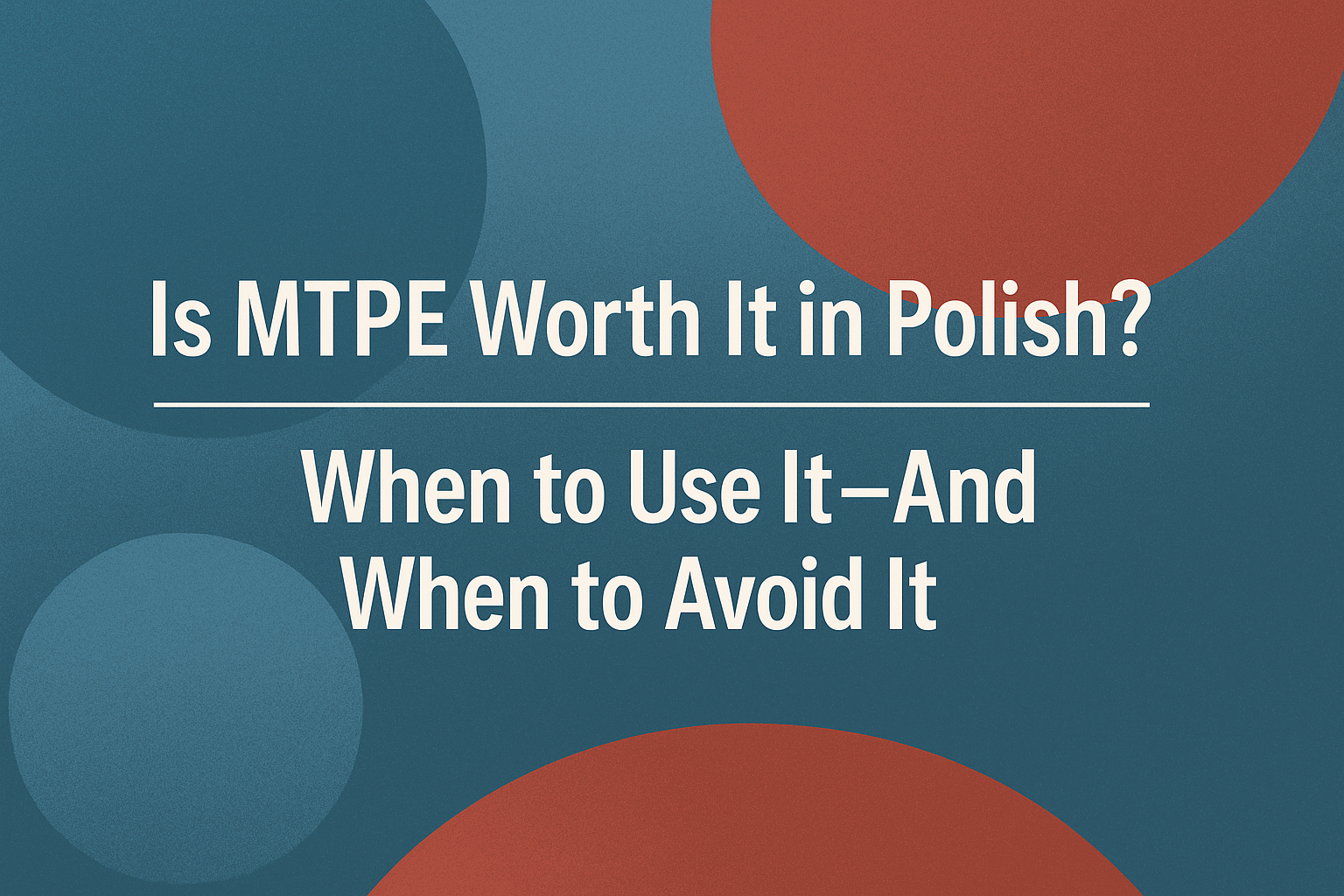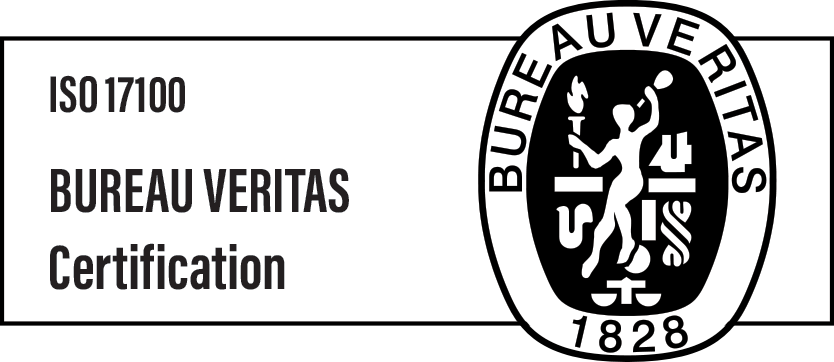Is MTPE worth it in Polish? When to use it—and when to avoid it

Machine translation and its growing role
Machine translation (MT) has come a long way from its clunky beginnings. Today, it’s used by global companies to cut costs and speed up the translation process. As the quality of engines improves, many language service providers (LSPs) offer a service called MTPE—machine translation post-editing—as a way to combine the speed of automation with the accuracy of human review.
For many types of content and languages, MTPE can be a practical and effective solution. It allows translators to focus on refining pre-translated content instead of starting from scratch. The promise is clear: more words in less time at a lower cost. However, this isn’t a one-size-fits-all solution.
When it comes to Polish, the equation changes. Polish is a morphologically rich and syntactically complex language, and that affects how well machine translation performs. For companies working with Polish content, the question isn’t just whether MTPE is available—it’s whether it’s worth it.
In this article, we’ll look at how MTPE works, why Polish presents unique challenges, and how to decide when MTPE is a smart move and when it could hurt your brand or product. Whether you’re a project manager at an LSP or a localization lead on the client side, this guide will help you make better choices for your Polish language projects.

What MTPE really is—and why it’s tempting
What MTPE really is—and why it’s tempting
Machine translation post-editing means taking raw MT output and refining it with human effort. It’s a hybrid process: the machine does the first pass, and a linguist improves it. There are two main levels. Light post-editing is about fixing only the most glaring issues, such as grammar errors or confusing phrasing. Full post-editing goes deeper, aiming for a polished, fluent text that resembles a human translation.
On paper, MTPE has obvious appeal. It promises faster turnaround times, more output per hour, and lower cost than traditional translation. In high-volume scenarios—like e-commerce product descriptions, support documentation, or technical manuals—it can seem like the perfect solution.
It’s also easy to underestimate the effort involved. Just because a machine generates a translation doesn’t mean it’s close to usable. Poor MT quality often requires more than simple corrections. Fixing awkward structures, correcting factual mistakes, and ensuring consistency with termbases can be time-consuming.
The value of MTPE depends on three factors: the quality of the engine, the complexity of the source text, and the language pair. For some combinations, especially between closely related languages, MT can perform well. For others, it struggles. That’s why understanding the limitations of Polish in this context is so important. Before diving into MTPE, it’s worth looking closely at how this language behaves in translation and what that means for productivity and cost.

Why Polish puts MT engines to the test
Why Polish puts MT engines to the test
Polish is a beautiful language, but it isn’t easy for machines to understand—or translate. It has a rich system of inflections, flexible word order, and context-driven meaning. Words change form based on gender, number, and case. Verbs reflect tense, aspect, and sometimes even mood. What’s more, Polish sentences can often be rearranged without changing their meaning, which confuses statistical and neural models alike.
Most MT engines are trained primarily on English and similar languages, where word order is more fixed and grammar is less complex. As a result, when those engines are applied to Polish, they often produce output that is grammatically shaky or just doesn’t sound natural. Machines might get the basic message across, but they often miss nuances, idioms, or tone.
Another issue is ambiguity. Polish words can have several meanings depending on context, and machines still struggle to interpret that correctly. Even if the translation is mostly accurate, the sentence structure may feel awkward or robotic to a native speaker. That’s especially problematic when your content needs to engage users or reflect a brand voice.
In short, Polish demands more from MT engines—and more from post-editors. A linguist working on MT output in Polish might spend as much time fixing awkward phrasing and grammar as they would translating from scratch. That’s why the cost-benefit calculation is different for this language. It’s not just about whether the MT “works,” but whether the editing effort makes sense.

Quality versus cost—what’s really at stake
Quality versus cost—what’s really at stake
At first glance, MTPE seems like a smart way to reduce translation costs. But when you take a closer look, especially in the context of Polish, the equation often becomes more complicated. MT-generated text that looks decent at a glance can turn out to be misleading, incorrect, or stylistically awkward on closer inspection. When that happens, the time spent correcting errors—and ensuring the result meets quality standards—can quickly cancel out any savings.
For content that requires accuracy, clarity, and a specific tone, these issues matter. Think of legal disclaimers, safety instructions, marketing taglines, or UX microcopy. In these cases, even small errors can have serious consequences: misunderstandings, user frustration, or damage to your brand’s credibility. Fixing poor MT output is not just a technical task—it’s a reputational risk management issue.
There’s also a hidden cost that doesn’t show up on project invoices: editor fatigue. Linguists working with weak MT often find themselves constantly second-guessing the output. Instead of working efficiently, they spend extra time evaluating whether to fix, rewrite, or leave certain segments untouched. That kind of mental load reduces productivity and increases the chance of errors slipping through.
In short, MTPE can work well for the right type of content—but for Polish, and for sensitive or high-stakes material, it’s risky to rely on it without a quality-first approach. A small upfront saving may result in higher revision costs later, or worse, in a message that doesn’t land the way it should.

When MTPE works in Polish—use cases that make sense
When MTPE works in Polish—use cases that make sense
Despite the challenges, MTPE isn’t off the table for Polish—it just needs the right conditions. The best candidates are texts that follow predictable structures, have low emotional or creative content, and tolerate a few imperfections. Think of product catalogs, internal memos, service manuals, or support FAQs. These kinds of materials often use controlled language and don’t need a polished marketing voice.
For this to work well, preparation is key. One major success factor is source content quality. If the original text is clear, well-structured, and free of ambiguity, the MT engine is more likely to produce usable output. Controlled English—writing that follows predefined grammar and style rules—can significantly improve results when translating into Polish. Investing in glossaries and translation memories also helps align the MT with client-specific terminology.
Another important element is post-editor expertise. MTPE isn’t about just fixing a few typos—it’s about understanding both the source and target languages deeply enough to know when the machine is wrong, even if it sounds right. Skilled editors in Polish can quickly identify translation traps like false friends, word order slip-ups, or misleading grammar.
In practice, when the content is suitable and the process is well-managed, MTPE can speed up delivery and reduce costs without sacrificing quality. But it requires alignment between tools, content strategy, and editorial skills. Cutting corners—especially in Polish—rarely pays off.

When to avoid MTPE—and why human translation may be the better choice
When to avoid MTPE—and why human translation may be the better choice
MTPE can be a powerful tool, but it’s not the right fit for every project. Certain types of content are simply too nuanced, strategic, or creative to benefit from machine-generated drafts. Marketing materials, transcreation, branded messaging, and customer-facing websites often fall into this category. These texts rely heavily on tone, cultural relevance, and emotional impact—areas where machine translation consistently falls short, especially with Polish.
Another red flag is complex regulatory or legal content. Here, precision is non-negotiable. A mistranslated term in a contract or policy can lead to confusion, legal risk, or compliance issues. For this kind of work, it’s usually safer—and in the long run, cheaper—to rely on professional human translators from the start rather than post-edit potentially unreliable MT.
Even content that appears straightforward, like app interfaces or e-learning modules, may include context-sensitive language or require a consistent, polished user experience. If the MT introduces inconsistencies or breaks that experience, it can hurt product perception and user trust.
One practical way to decide whether MTPE is right for your Polish content is to ask three questions: Does this content tolerate imperfection? Can a trained post-editor fix issues quickly? Will the final quality reflect well on our brand or product? If the answer to any of these is no, MTPE probably isn’t the best route.
Choose wisely for Polish—MTPE is a tool, not a shortcut
Machine translation post-editing can be a smart way to manage time and budget, but only under the right conditions. When it comes to Polish, it’s important to set realistic expectations. The language’s complexity demands more from both the technology and the people behind it.
In low-risk, high-volume scenarios with well-prepared content, MTPE can offer real value. But for anything that requires tone, nuance, or accuracy, human translation is often a safer investment. The goal isn’t just to translate faster—it’s to communicate effectively.
Rather than treating MTPE as a default option, treat it as one of several tools in your localization strategy. Use it where it fits, skip it where it doesn’t, and always evaluate its impact on quality, workflow, and end-user experience.
If you’re working with Polish and not sure whether MTPE is right for your project, talk to your LSP. A well-informed discussion about content type, quality goals, and language-specific challenges can help you make a decision that saves time without sacrificing trust.

